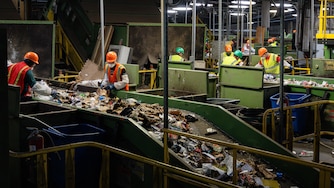Maryland officials will not have to fully evaluate how a planned replacement for the Francis Scott Key Bridge will affect the surrounding environment, including the Patapsco River, federal officials said this week. The move clears a hurdle that could have delayed an already lengthy rebuild process.
The Federal Highway Administration issued the exemption from the National Environmental Policy Act, or NEPA, because the state anticipates the future bridge will share key characteristics of its predecessor — four travel lanes and the same location. The rebuild “will not result in any significant impacts to community, natural, or cultural resources,” the federal agency wrote in its decision, adding that it believed impacts on natural resources to be “minimal.”
An environmental impact statement, commonly referred to as an EIS, or the less-comprehensive alternative, an environmental impact assessment, is typically required by federal law for significant projects. The cost and timetable for finishing them can vary greatly depending on the scope of the project, but they can take years for large infrastructure; an EIS can also stall a project based on the anticipated impacts that are found.
Foregoing such a study keeps Maryland on its anticipated timeline of having drivers traverse a new bridge by late 2028. The Maryland Transportation Authority plans to award a contract for bridge design by the end of the summer. The agency also put out an additional request for bids last week for a roughly $75 million contract to assist in managing the future design-build.

The environmental exemption could dash the hopes of some in the community who argue that the state shouldn’t just focus on rebuilding what once stood, but building something new with more capacity.
Nearly four months ago, a massive container ship, the Dali, lost propulsion and struck a support pier of the Francis Scott Key Bridge in the wee hours of the morning. The bridge fell in seconds. It set off a monthslong effort to recover the bodies of six construction workers who fell to their deaths and clear the wreckage from the Patapsco River.
“Securing this approval marks a major milestone in rebuilding the Key Bridge and reconnecting communities following the March 26 catastrophic collapse,” said Maryland Transportation Secretary Paul Wiedefeld in an emailed statement.
The focus is now on Gov. Wes Moore’s fourth and final directive — rebuild the bridge. Moore said in June that he wouldn’t be satisfied, “until I can look over on the Patapsco and see the Key Bridge standing tall again.”

Around town, some have dreamt what a future bridge might look like, floating new design features like a pedestrian-friendly path or even a bike lane. Some such ideas may not hold water as the Baltimore Beltway, which the future bridge will once again make whole, is designated an interstate highway and will adhere to corresponding regulations. Certain smaller-scale specifics, like the addition of a bike lane, are being considered and will get worked out as the design progresses.
But the environmental exemption signals that larger changes that would modify the state’s request-for-contractor proposals — and in turn require an updated environmental study — could now be off the table. Some have argued the state should add more car lanes to the future bridge, while others have floated more creative additions.
The Baltimore Transit Equity Coalition, which strongly supports the planned Red Line light rail project connecting East and West Baltimore, recently released a statement urging the Maryland Transportation Authority to accept bridge designs that could allow for the future addition of light rail track. That would potentially allow for a future expansion of the Red Line, which some lawmakers already envision being extended east into Baltimore County and over the future bridge into Anne Arundel County.
“The rebuilding of the bridge will affect the city for decades to come, and we must have the foresight to determine both what is best for the rebuilding of the city now, and what can catapult us into the future,” the BTEC statement read. “A multimodal design — one that includes light rail, bike, and pedestrian access — is the most suitable and visionary solution.”
The request for design-build proposals released by the state last month puts the effort on a “very bureaucratic track” that lacks the unified, multiagency energy that made the bridge recovery so fast, said Klaus Philipsen, an architect who has worked on major state infrastructure projects. He’d like to see that energy carry over into the rebuild to speed up the timeline and to better involve the surrounding community.
“Let’s brainstorm as to what we really want to achieve here. Do we want more road capacity? I would say no, but do we want … space to get over by another mode, maybe transit, maybe bicycle,” Philipsen said. “I do think we need to be wide open to solutions.”
Such brainstorming, however, could slow the rebuild process down at a time when drivers are struggling to adjust to traffic patterns that have been scrambled by the bridge’s collapse. The Key Bridge used to carry more than 30,000 vehicles a day over the Patapsco River. Its absence has increased traffic pressure on the two tunnels underneath the river, while forcing drivers of trucks carrying hazardous materials to take the long way around Interstate 695, the Baltimore Beltway, to connect with Interstate 95.
The Baltimore Banner reported recently that some trucks carrying hazardous materials have illegally been using Baltimore’s I-95 and Interstate 895 tunnels.




Comments
Welcome to The Banner's subscriber-only commenting community. Please review our community guidelines.